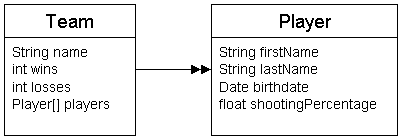Object model
Each business object is represented by a class that has both attributes and behavior. We have subclassed each object under the Observable class, which allows other objects to be notified when the business object changes state. The individual classes are described below.

The Team object
name, which is read-only and which serves as the functional key for the object. The only time a user of this class can set the name is on object creation. The other attributes (wins, losses, and players) can be modified throughout the lifetime of this object.
We enforce the encapsulation of the attributes by making the attributes have non-public visibility. Instead, we provide accessors ("setters") and mutators ("getters") that have the same name as the attribute. Also, in all the mutators, we notify anyone who might care (the Observers) that the attribute has changed. The argument that we send along with the notification is the name of the attribute that changed.
The Player Object
firstName, lastName, and birthdate. Again, you can only set these attributes when you are creating the object. The last attribute, shootingPercentage, can be changed throughout the lifetime of the object.One special note about the Date class. It seems that it can't represent a date that occurred before 1970. This sucks. Since this is just an example, I've just made all the players 10 years younger than they actually are, but this obviously won't work for real business applications.